|
I have been working on the 1923 Old town and the 1908 Morris. The Old Town is about done and
for updated info scroll down the page. Although I have done
a lot of work on old craft, I have done very little on canoes. So
in order to get up to speed on canoes I started on the late 1950 or early 1960 Goodyear Synthetic. This canoe
was built as an experiment by the Goodyear company using a type of
mold and induction to fold a sandwich of exterior skin over a central
foam core shape of a canoe. I do not know what level of success that
they had, but the example that I have was deemed a “second” due
to noticeable folding flaws in the interior and exterior of the
finished hull. I bought the canoe from a friend on Cape Cod named
Fred Sands in Orleans Cape Cod Mass in 1972. His dad, I think who was also
named Fred, purchased the “second” from Goodyear and built oak
gunnels, keel and thwarts, with mahogany breast hooks and seats.
These were basically slab arrangements but allowed the canoe to be
used for fifty years by me and the kids. Over time the keel was lost
and damage sustained periodically by normal use as well as the
kids inadvertent dropping her out of the back of a pickup at speed on a
road to Carbuncle Pond or a river in North Kingstown RI. After
bringing the canoe with the others to Stover Mo in 1994, and after finishing
the other boat projects that I brought out here, It was time to look
at the Canoes. The 1923 Old Town that I purchased in RI and started
restoring there and the 1908 Morris that I purchased with another Old
Town that I found on a burn pile in New Jersey ( I no longer have
that Old Town) were pulled down out of the barn with the Goodyear
Synthetic. When I learned that I had a couple of relatively rare canoes, I
decided to look at the Goodyear as a training course on canoe repair.
It turned out that the gunnels
of the Goodyear were in need of replacement and the thwarts seats
and breast hooks were slab sided and could use an upgrade. All or the
wood was removed. I have an old early 1900s barn made of oak beams
with 1” oak siding. Many of the excess oak boards used in the
siding were laid down as a unsecured flooring on the hay loft. Some
of these 100 plus year old planks were edge grained clear planks a
foot or more wide around 14' or more in length. The canoe is 16.5”
long, but a scarf utilizing this excellent lumber was utilized. I
found that a 1/16” or so of the gray exposed boards removed by
sanding and plainer revealed excellent wood for the gunnels and keel.
There is no real curve up at the bow and stern of this canoe, so no
steaming was required of this old wood. But with an internal and
external cut out bevel to accommodate the thickness of the Goodyear
hull material, I could work with an excellent wood with nice tone for
the gunnels. The breast hooks and seats were made of
Philippine Mahogany, the
wood was fine enough for use as new breast hooks. Originally the
breast hooks were just square slab units below the thwarts like the
seats, but with the gunnels in place I could remove the bad surface
wood and give them a nice vee cut inner edge and fit them flush
with the new gunnels.
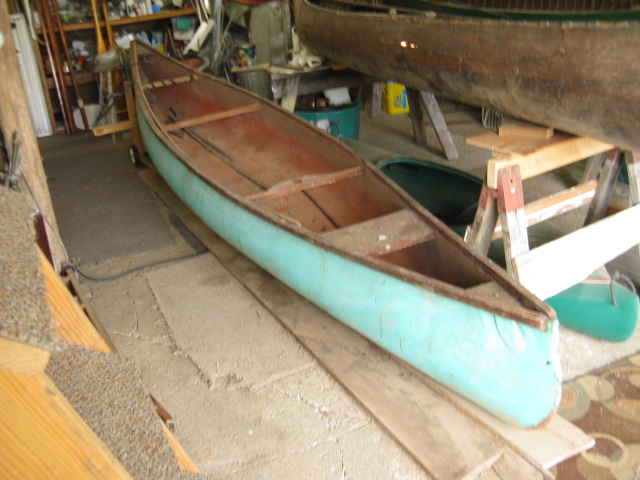
The seats and thwarts needed complete
replacement. Fortunately I have excellent templates from the 1923
Old Town, which I used. The Old town was sold with a sailing rig, and
since I originally added a sailing rig to the Goodyear, the Old
Town examples would be much better than my jury rig design when I
fitted it up back when I didn't know any better. The Old-town seats
and thwarts are ash (I think) but the Morris seats and thwarts are Mahogany.
Since the breast hooks are Mahogany on the Goodyear canoe, I chose to use
Philippine mahogany for the seats and thwarts. Some of the boat part
that I carried out here from Rhode Island were from a 25' 1948 cabin
cruiser named Nassau II out of Newport RI. The flat head V8 went to a
fellow in Florida building a Mahogany speedboat, but the wheel
console of Philippine Mahogany was upstairs in the barn. So it was re
cycled into thwarts and seats using the Old-town parts as templates.
When all that was done and varnished, I ordered and received
the cane for the seats, and the Goodyear seats built and the Morris and Old town seats are restored and all three canoes
have new caning in place...
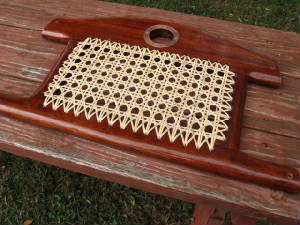
Last summer I finished the Oldtown canvasing and filling, and while it cures for the winter, I started on the Morris. I had
fiber-glassed it back in the 1980s when I found it on a burn pile in New Jersey just to get it usable and not knowing its
rarity. I refurbished and re caned the seats on all three canoes last winter. While the Oldtown canvas cures the Morris has
been moved over to the work area. I thought that the fiberglass removal would be very difficult, but surprisingly it came
off easily in strips leaving only areas of resin behind. If the hull was oiled prior to canvasing, that would explain the
fiberglass not soaking into the wood very much. Four hours sanding removed the resin, and the planking is mostly pretty good.
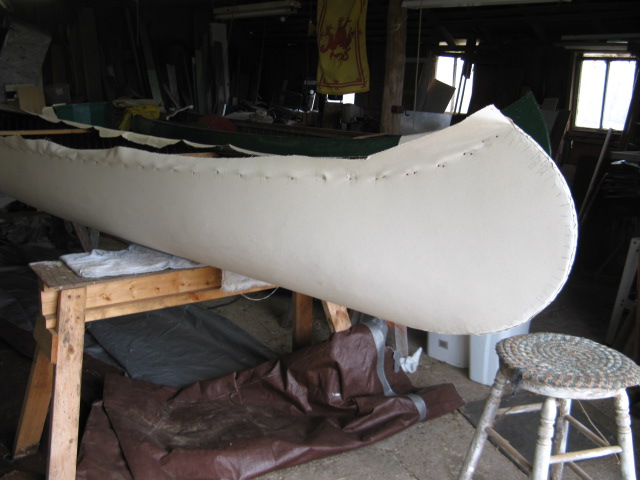
The 1923 Oldtown with new canvas November 2019. Almost one hundred years old, but young at that...You have to fudge around
a bit with it but it is not hard to get a nice covering as long as your hull prep work has been good...
Below is a picture of the almost finished Old Town. The upper one shows the canoe after canvas and sealing.
Picture here
| undefined |
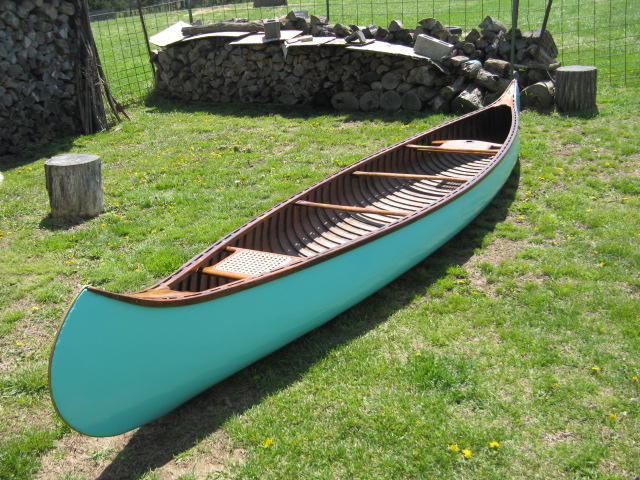
|
| undefined |
The 1923 with sealed filler all smoothed out. It was a bit of work to judge the consistency of the filler for rubbing smooth,
but not too bad. I had a temperature in the shop around 60 degrees, but I had a few warm days before we slip into the cold
of winter here in Missouri. It had about two weeks of reasonable temperature and has set up well so far. I moved her over
to the side and moved the Morris to the work side of the shop. The canoe is now painted with new outwales and all put back
together. The canoe originally came with a keel but I have not yet decided whether to put one on or not. I do have some nice
100+ year old oak for the job if I decide to put one back on.
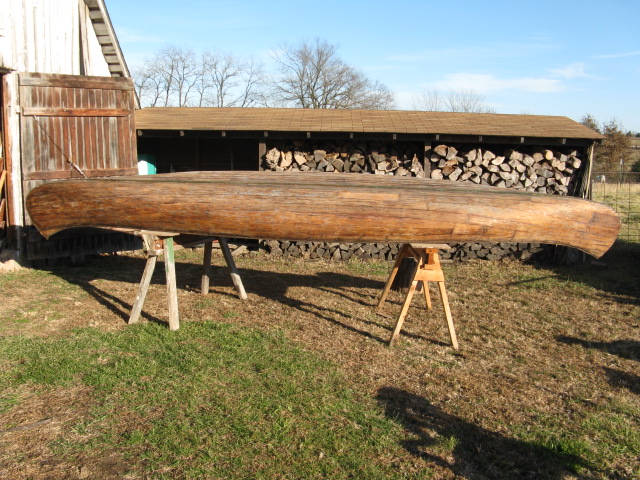
Here is a shot of the 1908 B.N. Morris after removal of the fiberglass and the remaining resin sanded off. The planking is
generally in pretty good shape, but of course some work on the planking will be required. I steamed in eight half frames replacing
broken frames and replaced about 7' of the port inwhale due to rot. Resin needs to be removed from the gaps between the planking,
but at least the resin does not appear to go very deep.
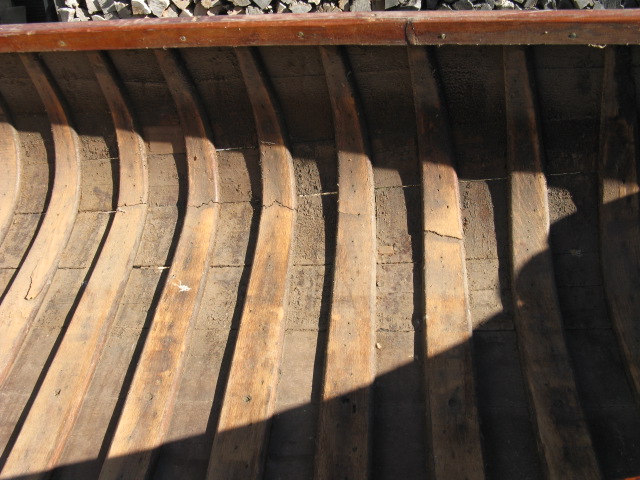
Here is a shot of the cracked frames prior to their removal and new half frames steamed in as you can see below. The new frames
pulled in the planking nicely.
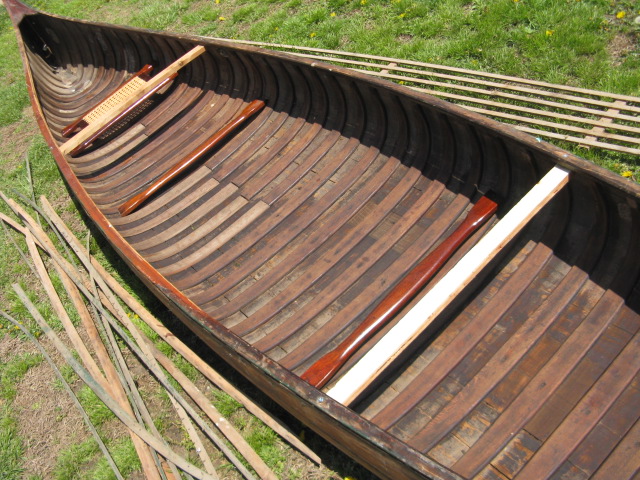
This is a new shot of the Morris interior as of April 24, 2021. Eight new frames have been steamed in and although the shot
does not show it, the eight three are stained. There are a couple of cracked frames that I did not replace because I felt
that more damage would occur than the cracks represented.
Over the winter I have removed the cracked portion of eight frames, pulled the planking back into line and steamed in eight
half frames in the cracked frame area. Cedar framing and canoe tacks were acquired from "North Woods Canoe company in
Maine. I also repaired the bad section of port inwhale section. This canoe is complete with floorboards, redone and cained
seats, thwarts, and rail caps. Most but not all of the out whales are there but may need replacing.
|



